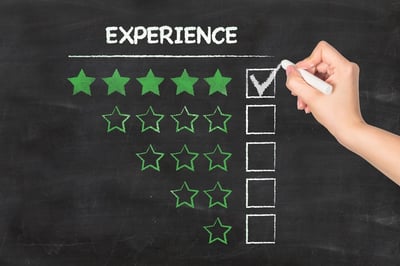The 4 Levels of Customer (Resident) Experience
by Joanne Chapman-Reps | Oct 20, 2017 12:00:00 AM
 Open up any business publication and it’s a pretty good bet you’ll see something that talks about customer service or the customer experience. In the multifamily industry, the focus by nature is on our customer - the resident.
Open up any business publication and it’s a pretty good bet you’ll see something that talks about customer service or the customer experience. In the multifamily industry, the focus by nature is on our customer - the resident.
However, one problem with much of what’s written on the topic is that customer service and customer experience is often used interchangeably. To drive the type of results you want from your initiatives, you must understand the difference between service and experience, and the continuum of customer experience.
Customer service is about process. It's a lot of the standards and internal processes. It's the basics that we have defined for our teams: the stand, smile and greet, the way that we engage with a customer when we meet them, when they come in the office, when we pick up the phone and so on.
Customer experience, on the other hand, is a journey that companies go on as they start to evolve from providing service, that’s focused on our processes, to truly focusing on the customer and crafting an experience designed for them: and equipping our teams with the necessary processes and products to deliver that experience purposefully.
Customer service is about standards, processes and techniques. Customer experience is how everything comes together to create an experience for the customer, and it’s how that experience feels to the customer.
As you design your intentional customer experience, it’s important to understand there are, in essence, four levels of experience:
1. Random
A focus on customer experience starts as an initiative. It is something that you build into the fabric of the organization. Before companies start to focus on creating an intentional experience for their customers the service provided is completely random. It’s person dependent and relies on the best efforts of the people and the various levels of service that different people provide.
For example, I have a Safeway near me. I know when I go in, there's a lady named Jeannie, who is excellent. I know if I go to Jeannie, I will get an excellent experience. I know if I go to the cashier two aisles down from her, I’ll get Sue - who is usually a pretty grouchy person and really shouldn't be in front of people. It's very random at that store. It’s important that operators move from that to a predictable experience.
2. Predictable
This level is defined by a clear standard of service that is delivered (at least somewhat) consistently. This is often what a focus on customer service gets you. There’s consistency from person to person and customers know what to expect. It’s a meaningful step above providing random experiences, but it’s not enough to stand out in today’s world.
A common problem at this level is that the focus is on “doing things right” rather than “doing the right things.” Residents can feel “serviced” here, as the experience is lacking the human element.
3. Branded
To get to this level, it takes standards and the basics as well as a process to ensure that these happen all the time, at every interaction. The key element here is a focus on the empowerment of your teams to be able to deliver a great customer experience and to respond to service recovery opportunities in a timely manner and the way the customer prefers.
Southwest is a great example of a company with a branded level of customer experience, and they do this in an industry notorious for poor experiences. Southwest empowers their associates and their team looks at everything they do as creating an experience. They realize that there's a bigger picture and they're about building relationships and not focusing on the transaction. They're very “feeling oriented”.
At Southwest, associates are empowered to see the customer as a person. Instead of going to a script, like other unhappy airlines use, Southwest’s approach with their associates is more like, “You know our business. You're closer to the customer than we are. You can do it in the way that feels right, that creates the best experience, and not in this rote way that we're requiring. That's so transactional that it makes you feel invisible.”
4. Loyalty
When you create an intentional customer experience you must first understand the drivers of customer loyalty in your organization, and then start to design an experience that creates loyal customers. The next step is to equip the teams to deliver this experience throughout the organization. This helps align the organization around the experience and understand its importance.
We’ll cover what’s required to do this successfully in a future post!